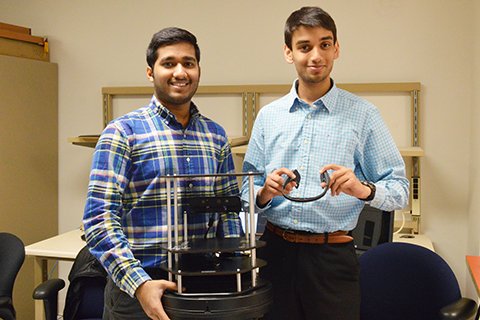CSE students win BizPitch student entrepreneur competition

Students to reinvest $1,000 prize in their invention to help wheelchair users
MINNEAPOLIS / ST. PAUL (12/08/2017) — The opening lines of Stephen Mylabathula and Furqan Syed’s 90-second business pitch explained how 2.2 million American wheelchair users struggle with using complicated devices like joysticks to get around.
“But what if there was a solution?” the two University of Minnesota College of Science and Engineering students asked.
Enter Mylabathula and Syed’s proposal—a headband that uses data from brain signals to move a wheelchair simply based on the subject’s thoughts and head movements. The pair won first place in the University of Minnesota annual BizPitch student entrepreneur competition, earning $1,000 to support their entrepreneurial idea.
Mylabathula, a junior studying computer engineering, came across a similar headband while competing at the MIT International Hackathon. The headband was originally used for determining a person’s mental state during meditation, but Mylabathula and his group decided they could use it to control the movements of a small robot. After placing in the top 10 at the Hackathon, Mylabathula brought the idea back to the University of Minnesota and his friend Syed, a sophomore majoring in computer science.
Both students had always been interested in entrepreneurship, and the BizPitch contest gave them the perfect opportunity to exercise their business proposition. Aside from earning the $1,000 prize, they dubbed the competition as a learning experience.
“It wasn’t about the money,” Syed said. “It was really about the fact that we got other people to take the time to listen to us and seriously consider our idea.”
The two also acknowledged the importance of having science and engineering backgrounds as a basis for their entrepreneurial endeavors. Mylabathula has been researching under computer science and engineering Professor Stergios Roumeliotis, an experience Mylabathula says was integral to this process.
“When you do engineering problems, you get this mindset of identifying the problem, breaking it down into sub-problems and then solving it that way,” Syed said. “I think that’s the benefit a science and engineering education gives.”
“You get that depth in engineering,” Mylabathula added. “I also appreciate entrepreneurship, but I’m passionate about robotics, so that’s why I want to approach entrepreneurship with this as my toolset.”
As for what’s next, Mylabathula and Syed plan to create their own headband that is optimized for working with wheelchair users and to register their company with the Secretary of State. The students are already doing market research to gauge interest and develop ideas for their product. Mylabathula said the challenge comes with incorporating a safety system in case the wheelchair refuses to stop.
“We want to have a second layer of security so that if a person wants to stop, they can stop,” he said. “I think that’s the most important thing.”
The students’ 90-second business pitch concluded with the fact that they are “extremely excited to bring back natural mobility to thousands of people.” With a unique idea, engineering savvy, and $1,000 in hand, Mylabathula and Syed are wheeling away to start their first innovative company.
Story by Olivia Hultgren
If you'd like to support University of Minnesota College of Science and Engineering student entrepreneurship, visit our CSE Giving website.
